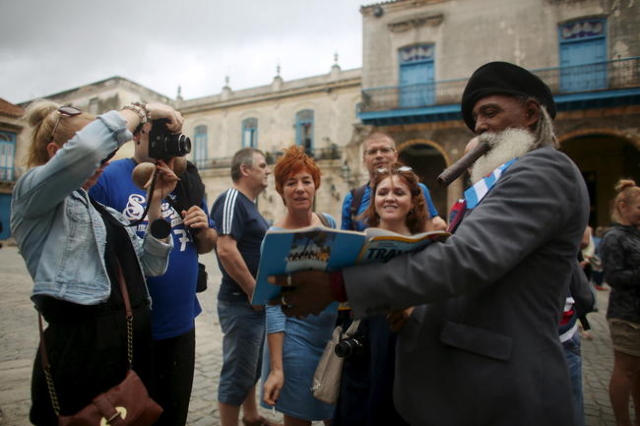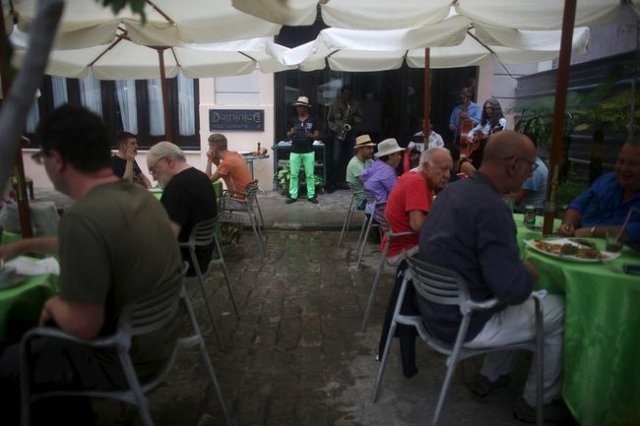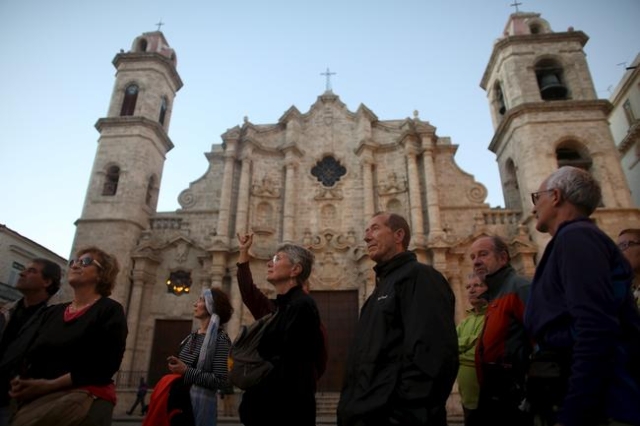Surge of Americans tests limits of Cuba’s tourism industry















HAVANA — Cuba‘s tourism industry is under unprecedented strain and struggling to meet demand with record numbers of visitors arriving a year after detente with the United States renewed interest in the Caribbean island.
Its tropical weather, rich musical traditions, famed cigars and classic cars were for decades off limits to most Americans under Cold War-era sanctions, but those restrictions are fading.
Once a rare sight, Americans are now swarming Old Havana’s colonial squares and narrow streets along with Europeans and Canadians.
Entrepreneurs and hustlers have responded by upping prices on taxi rides, meals, and trinkets. Cuban women who pose for pictures in colorful dresses and headwraps while chomping cigars are now charging $5 instead of $1.
Cuba received a record 3.52 million visitors last year, up 17.4 percent from 2014. American visits rose 77 percent to 161,000, not counting hundreds of thousands of Cuban-Americans.
Industry experts worry the island will be unable to absorb an even greater expected surge when scheduled U.S. commercial airline and ferry services are due to start this year.
As it is, foreigners face extreme difficulties booking hotels and rental cars, and those who hoped to discover Cuba before the hordes arrive realize they are too late.
“Cuba is over the top with tourists right now. I’ve seen so many Americans, it’s not even funny,” said Ana Fernandez, 44, of Nashville, Tenn.
Gisela Hoiman, 46, a schoolbook editor from Berlin, hoped to see Cuba “before it changes” but was disappointed to find long airport lines, ubiquitous hucksters and masses of tourists. She was stranded in Havana when she was unable to get a spot on the bus leaving for the eastern city of Santiago.
“It was too much to handle, too many other tourists. We stood in line and were sent back and forth to different counters,” she said from an Old Havana cafe with her large backpack parked on the floor. “I don’t think Cuba is prepared.”
The United States and Cuba agreed in December 2014 to end five decades of animosity and have since restored diplomatic ties, igniting international buzz about Cuba.
The opening has benefited Cuba‘s small private sector, which offers restaurants and rooms for rent in family homes.
But the tourism infrastructure, with just 63,000 hotel rooms nationwide, is still largely a function of the state and has languished under decades of U.S. economic sanctions and underdevelopment.
“From offloading at the airport to restaurant availability, infrastructure is maxed out,” said Collin Laverty, founder of Cuba Educational Travel, which organizes tours for legally permitted travel for Americans.
A select number of foreign-run hotels, such as those of Spain’s Melia Hotels International SA, fill up fast, leaving many visitors with little option but tired state-run motels or rooms in private homes.
Some have been priced out or bumped from hotels, especially in Havana, where high-end U.S. groups reserve blocks months in advance and pay higher prices.
“It is kind of a slap in the face as it has been the Canadian and European tourists who have helped keep the Cuban economy afloat for the past 25 years,” said Keri Montgomery, owner of Vancouver-based Finisterra travel.
The government is seeking more foreign investment and has plans to reach 85,000 hotel rooms nationwide by 2020, but the pace is slow and development has mostly favored beach destinations rather than Cuba‘s cultural centers.
Cuban officials did not respond to Reuters requests for comment.
FORBIDDEN FRUIT
American tourism is still banned under the U.S. trade embargo but U.S. citizens and residents are allowed to visit under 12 categories including for religious, sporting and educational exchanges.
In one of his first moves after rapprochement, Obama made it easier for those 12 categories of travelers to go to Cuba.
The increased presence of Americans is especially noticeable in Havana, and because there has been little enforcement of the tourism ban, some are also enjoying Cuba‘s beaches and bars with little effort to disguise their intentions.
The Treasury Department’s Office of Foreign Assets Control has not fined any Americans for visiting Cuba since Obama took office in January 2009, its database shows.
Under President George W. Bush, OFAC fined hundreds of individuals for embargo violations, mostly for travel. More than 800 people received penalties including nearly $1.1 million in fines in 2004 and 2005 alone, according to a 2015 report by the Congressional Research Service.
California native Tony Pandola, 33, who has been leading Americans around Cuba for three years, said once-intimate experiences are now plagued by crowds.
“On this really beautiful, quiet farm there were six giant tour buses with their diesel engines running and a couple of minivans and taxis all waiting to have the same experience with the tobacco farmer,” he said from Viñales, a picturesque valley west of Havana.
While many budget travelers can usually find accommodations even without booking, some are left stranded.
“I talked to a cab driver in Viñales who said they were offering tourists to sleep in the back of their car for $10,” Pandola said.
Leonardo Diaz, 34, who has been working in tourism in his hometown of Viñales since he was a teen, said every room was booked in December.
“A lot of tourists have stayed in the park. That had never been seen before,” he said.
Havana’s international airport lacks sufficient infrastructure such as luggage trucks and passenger stairs to handle the influx, causing bottlenecks.
“It’s total madness,” said Roniel Hernandez, who works at the terminal receiving U.S. flights. “The airport employees are doing everything possible to satisfy visitors, but the equipment is very old and needs to be replaced.”
Retired teacher Joanna Sarff finally came to Cuba after dreaming about it for 50 years, so she refused to let the inconveniences spoil her trip, saying she was more focused on plans to dance on the tables at a Buena Vista Social Club concert than the crowds.
“For me, this is a great way to experience the culture, the people, the food, the mojitos, and the cigars!”












